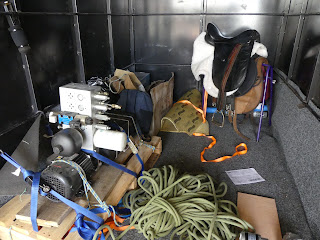Detecting Open Reins... using a mouse
I've previously talked about the need to be able to reliably detect open reins. The sensors in the back of the mouth are good for detecting general rein pressure, but they don't detect the sideways pressure that is ultimately what an open rein creates, based on my current understanding. For example, with my "head on a turn-table" setup, if I create an open rein to one side or the other, then the head rotates in that direction, confirming that there is a sideways element to the force created.
The in-mouth pressure sensors aren't sufficient for this, as the open rein aid applies primarily a lateral force, which is at right-angles to the mouth sensors. It is possible that I can measure that force directly -- perhaps via sensors between the cheeks and snaffle rings.
I have also been thinking about using an optical computer mouse to directly record the rotation induced in the head and neck by the aid, as with the nice smooth bearings I have used, the head does move in response to a reasonable application of an open rein. However, once I have the head motorised to rotate under the horse's own intentions, that alone won't be sufficient, as the head will no longer rotate freely if a motor is attempting to hold it in position. Similarly, if the head is set up to bobble like a real horse's when it is walking or moving in other gaits, this will get more complicated.
I used ChatGPT-4 to explore some other ideas, and one interesting idea it has me thinking about, is using cheap DIY torsion gauges to measure the rotational force directly. This could be done using a computer mouse attached to a spring, which is setup so that it experiences the torsional force when the head rotates, thus causing some part of the spring to rotate, that the mouse can track as linear movement.
It might be that pressure sensors on the neck are also required -- which also means building a more anatomically shaped neck, so that the light pressure of the rein along the neck on the opposite side to the open rein can be measured.
Personally, I suspect that real horses are cuing at least partially on this information, as it fits with their whole approach of moving away from pressure to find relief from the pressure -- which is actually how the open rein works:
1. Opening the rein to the right, pulls the right side of the bit towards and to the right of the rider. This increases the overall tension on the reins.
2. The rider with their left hand lowers the reins, and brings them towards the centre-line of the horse. This provides an increased connection of the left rein to the horses neck, which it may be able to feel directly.
3. Additionally, the movement of the left hand, combined with that of the right hand, results in increased force on the left side of the mouth in the approximate direction of the riders right hand. With the current mouth sensor setup, this means that an open rein will tend to be interpreted as increased pressure on the left side, and vice-versa.
Adding cheek sensors may enable detection of the release of pressure on the open side, and similarly, the increase in pressure on the opposite side. Neck sensors will potentially be able to detect the light pressure of the reins against the neck.
That just leaves measuring the induced rotation on the head, which I am still planning to measure using an optical mouse. I just need to make a means of holding the mouse very close to the surface of the table (or creating an elevated platform very close to the neck), as the depth of field of an optical mouse is only a millimetre or two.
I have a jig that holds a mouse that my Dad and I built some time back for use with a minecraft farming game that my son liked to play with me. This consists of two pieces of wood with a cut-out that can fit the mouse, and between them a piece of tyre tube is stretched, which ensures that the mouse rides up to the upper surface. It then just needs a means of stopping the mouse "escaping", which for that was some thickish pieces of aluminium:
I only have a hole saw that is 25mm, instead of the 20mm of the shaft, so I added some relief cuts, so that I could clamp it shut around the 20mm shaft:
Like this, using just electrical tape to bind the ends together. Mouse cable routed for strain relief:
Putting it all back together:
And a close-up of the mouse:
At this point, the mouse happily moves around on the table top, and senses the rotation very nicely. So I hooked it up to one of the playable demos of Unbridled: That Horse Game, to have a bit of a play at controlling it using the reins:
... which works pretty well, as you can see in the following short video:
Next steps is to have the mouse feed into something that can generate synthetic keyboard events, so that I can give the expected input type to the game, and then it will be able to really control the horse. I'll then work on integrating this with the mouth sensors and also adding those neck and cheek sensors, to get a complete rein sensing setup done.









Comments
Post a Comment